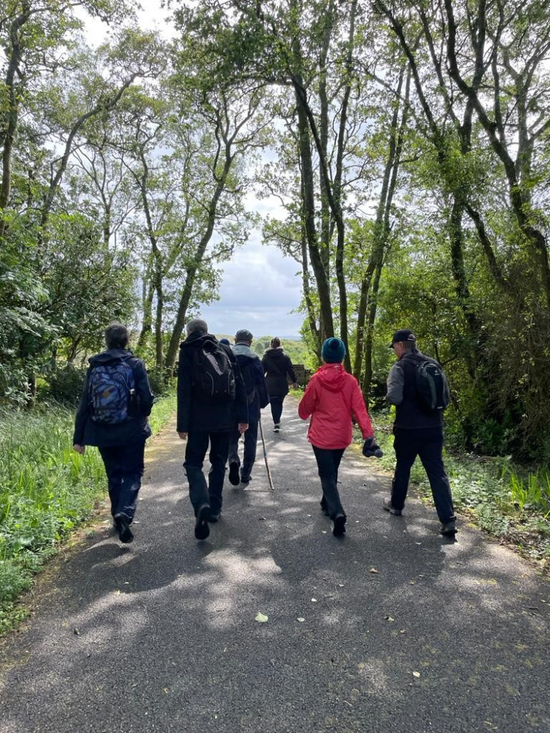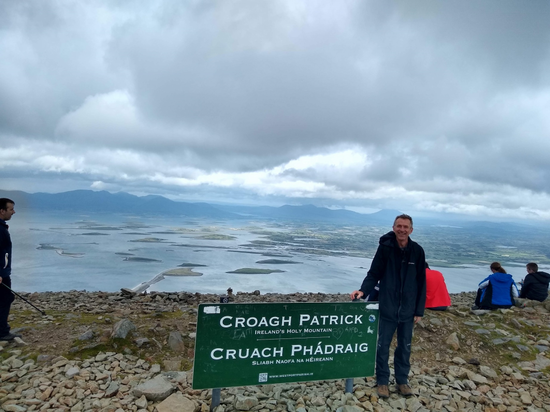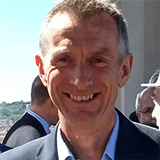On the Holy Mountain and Other Places
July 17, 2023 Blog
I was back in the West of Ireland for our Emigrants Walk in Mayo and took the opportunity to make a couple of sacred little trips.
The first was to Glenamaddy in Galway, near to which my dad was born and raised and where there still lives my Aunty Nellie who is the last surviving member of the family there. It was lovely to see her again. We took advantage of a lull in the rain to drive up to the graveyard to visit my paternal grandparents, both of whom died before I was born. And back at the bungalow we feasted on soda bread and ham and Barry's tea and Kimberley biscuits.
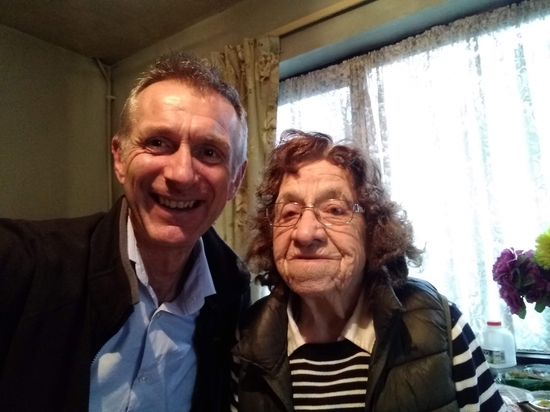
The following morning I checked the weather forecast for what was to be my third time going up Croagh Patrick, Ireland's Holy Mountain. It wasn't looking great. There was due to be heavy rain in the morning, then lighter rain from mid-day but with the possibility of thunder and lightning. I wasn't going to miss it so decided to wait until eleven o'clock before making the short drive over from Westport where I was staying to the starting point. Also, I'd told lots of people that I was going to do it. Some had asked if I was planning to walk up in my bare feet! No, I wasn't! The sharp stones on the final steep ascent are tough enough even in strong walking boots.
The rain was lashing down as I stood in an ominously empty car-park. I looked up at The Reek, the popular name for the mountain and which simply means high hill in Irish. St Patrick is said to have gone there during the Lent of 441AD, spending forty days and forty nights at the summit, praying, fasting and doing penance. At 765 metres above sea level it is Ireland's highest point and it is also the place from which Patrick banished the snakes from Ireland by chasing them into the sea. As with many sacred Christian sites, it is a place that had spiritual significance in pre-Christian times. The village of Murrisk which lies at the foot of the mountain is where the pagan harvest festival of Lughnasa was celebrated. Today, Murrisk is the site of the National Famine Memorial.
As I stood in that wind-swept car-park, I exchanged a few words with a brave father and son from Donegal who were setting off in their waterproofs and carrying their sticks. I got back in the car for a few minutes to eat a sandwich, figuring that if I ever made it to the top it would be too cold and wet to sit and eat. I eventually started walking and passed another ominous sign and one which I didn't remember having seen before. It was a notice from the Mayo Mountain Rescue pleading to pilgrims that if they felt unwell on the way up they were to come straight back down!
I soon got into my pace and caught up with the Donegal pair who were chatting with Michael. He was also from Donegal and part of a group of thirty-three who had travelled from his parish by coach. It was an annual event for them and the group included a priest who was to say a Mass in the little chapel at the top. I was told that I'd be most welcome to join them.
By some miracle the rain had stopped and when I turned round I was rewarded with views over Clew Bay that were as clear and as incredible as the two times I'd been there before. Five years previously, I had stood in that same spot and taken a photo of the estuary going out into the Atlantic, with the little islets dotted about. That picture I took of Clew Bay was to be used on the cover of my first book Looking Ahead with Hope.
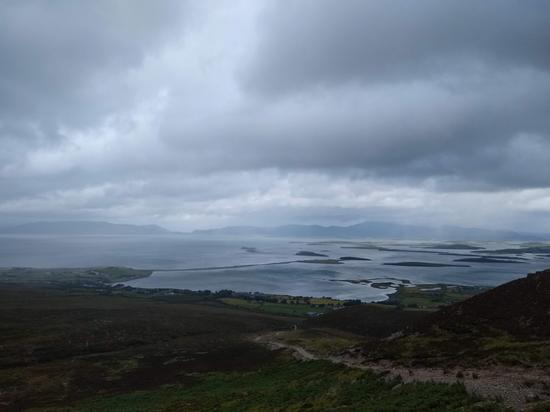
There was a new spring in my step as I passed more and more of the Donegal gang. They varied in age from five girls in their teens to a man in his eighties. And it was the latter who seemed to be getting up the quickest, certainly more so than his daughter who was struggling a bit! I had some lovely exchanges with several of the group. The path has been made gradually easier over the years and eventually I spotted the little white chapel and I was there on the top again.
Over the next hour I sat in what was now sunshine as the Donegal contingent arrived in dribs and drabs. When all were there, the priest opened up the chapel and we went in. It's a bit rough and ready and the floor was wet with some of the rain having got in, which prompted the priest to remark with a smile, "Well it's not the Sistine Chapel!" It really didn't need to be. We stood around the altar and it was one of the most enjoyable and prayerful Masses I've ever attended. The priest had said at the beginning, "We arrive here at this the highest and the holiest point in Ireland and we come with our struggles and our joys." We finished with a spontaneous verse of 'Hail Glorious St Patrick,' and then I thanked the priest. I said I'd always thought it would be special to go to a Mass at the top and that it had been special indeed. I left the group to their photo session and made a fairly hasty descent, getting back to the car-park just in time to miss another downpour.
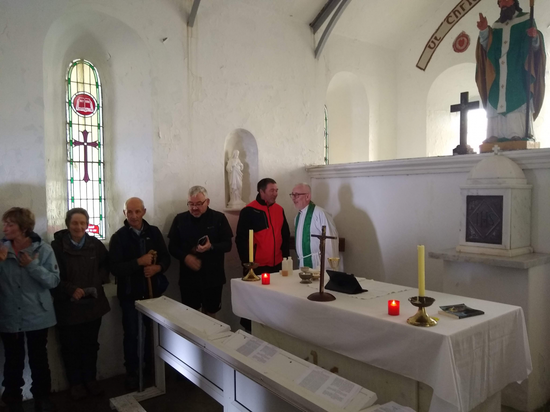
Shortly before that third ascent I had sent a message to Claire, who's from the West of Ireland herself and with whom I'd had a recent conversation about The Reek. I'd explained that I was just about to set off but that the weather wasn't brilliant. There was a most uplifting message from Claire awaiting me on my return: "Oh to be in Clew Bay in any weather! Every trip I make to Ireland is like a pilgrimage. My heart motivates and carries me while my soul sustains me as I navigate the emotions that envelop me until I am back in Islington and have the kettle on." She mentioned as well that one of the most enduring memories of her last visit to Croagh Patrick was, "sitting by the National Famine Memorial at Murrisk: looking out across the Bay, the beauty, the tranquillity, the absolute sense of connection with my ancestors. So much resonance. I hope you get to sit there."
I hadn't managed to sit in that spot but I sent a message back to Claire to say that at the end of my walk I had stopped at the bottom next to the statue of St Patrick and taken a deep breath and simply said 'thank you': for that incredible day in that incredible place; so too for my ancestors.
My ancestors were in my thoughts again the following day when we assembled in Mulranny for our Emigrants Walk. We had been warmly welcomed in the village by Karen and others at the office of Safe Home Ireland, a wonderful organisation that helps people who are returning to live in Ireland.
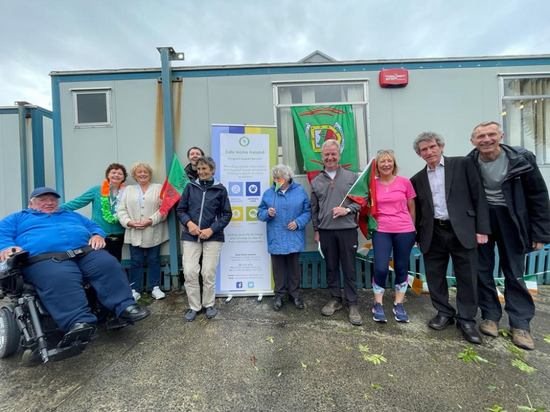
As we gathered on the Greenway for our 18km walk to Newport I said a few words. I explained that I'd been on a bit of a sacred journey in the West of Ireland. I spoke of how my Aunty Nellie had been one of two siblings who stayed in Galway. The other three, including my dad, had gone to England and, like many from Galway, had settled in the West Midlands. Dad had ended up in Coventry where he met my Newry-born mum at an Irish dance. I explained how many of those who had left Ireland in those post-war years were now elderly and living alone and sometimes with other issues too. I spoke of the great work of our Seniors Project in reaching out to them. And I said that we remembered all of those who had left their home in Ireland to go to a foreign land.
We made it to Newport for a welcome cup of tea in Kellys Kitchen. And I gave thanks for a very special and blessed few days in the land of my ancestors.
